Developed by Rianne Subijanto, Department of Communication Studies, Baruch College, CUNY
Professor Subijanto uses documentary films as important pedagogical materials, integrating them in most of her media classes including COM 3060: Media Analysis and Criticism.
Teaching with oer
 Professor Subijanto tried out several movie-streaming platforms and found that some platforms were more open and accessible than others. To access Kanopy, students need to put their information and sometimes certain films are not available. In these cases, because Kanopy is associated and often partners with libraries, she could contact her campus library to reserve a film in Kanopy for a certain period of time. However, later she found another platform, Thought Maybe where all of the films are available publicly online, making it a very good source of OER. Because it was completely open and accessible, Professor Subijanto now exclusively uses Thought Maybe for films and often uses Discussion Board questions source from the Media Education Foundation (more below).
Professor Subijanto tried out several movie-streaming platforms and found that some platforms were more open and accessible than others. To access Kanopy, students need to put their information and sometimes certain films are not available. In these cases, because Kanopy is associated and often partners with libraries, she could contact her campus library to reserve a film in Kanopy for a certain period of time. However, later she found another platform, Thought Maybe where all of the films are available publicly online, making it a very good source of OER. Because it was completely open and accessible, Professor Subijanto now exclusively uses Thought Maybe for films and often uses Discussion Board questions source from the Media Education Foundation (more below).
Students from Professor Subijanto’s classes have reported that they appreciate the open-access platforms since they can share links to the readings and films discussed in class with friends and relatives. Transitioning to OER has helped Professor Subijanto become more aware of the importance of common access to collective and open teaching materials. And she like providing resources that she knows her students can go back to these materials after the course is over.
The “COURSE ARTIFACTS” section below contains several OER film +discussion board pairings.
The oers
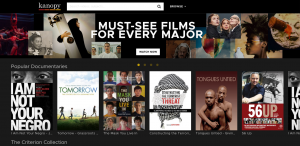 Professor Subijanto found that Kanopy was one of the best platforms for teaching since students could access the platform for free. (Kanopy is freely available to anyone with a library card or “.edu” email address.) Using Kanopy, Professor Subijanto assigned films for students to watch at home. This allowed her to reserve the in-class time for discussion. One drawback, sometimes films are unavailable and access must be requested through the campus library. Kanopy will lend films to university libraries and grant professors and students access.
Professor Subijanto found that Kanopy was one of the best platforms for teaching since students could access the platform for free. (Kanopy is freely available to anyone with a library card or “.edu” email address.) Using Kanopy, Professor Subijanto assigned films for students to watch at home. This allowed her to reserve the in-class time for discussion. One drawback, sometimes films are unavailable and access must be requested through the campus library. Kanopy will lend films to university libraries and grant professors and students access.
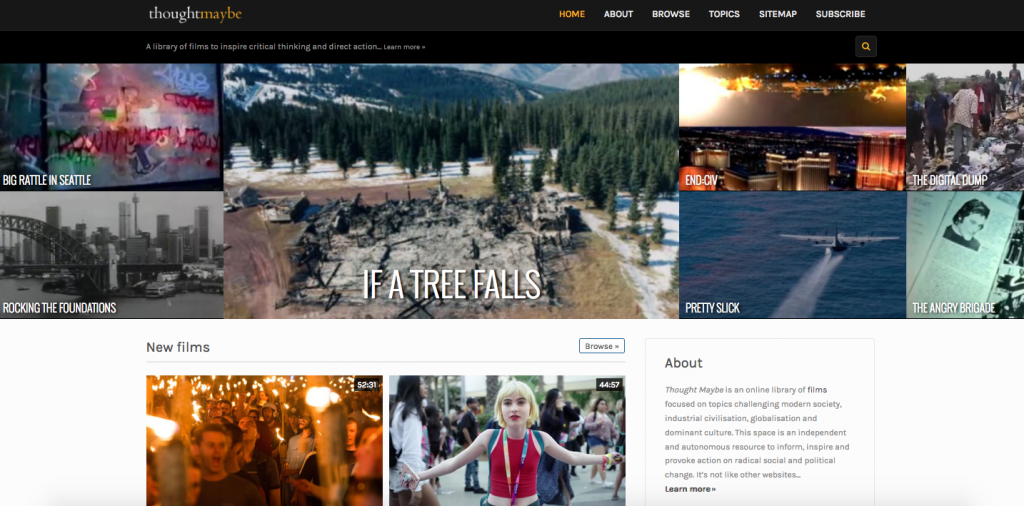 Similarly, Professor Subijanto also uses Thought Maybe, a site where all films are available publicly online, making it a very good source of OER. Films are categorized and labeled with keywords, making it easy to find a film that can accompany a particular topic.
Similarly, Professor Subijanto also uses Thought Maybe, a site where all films are available publicly online, making it a very good source of OER. Films are categorized and labeled with keywords, making it easy to find a film that can accompany a particular topic.
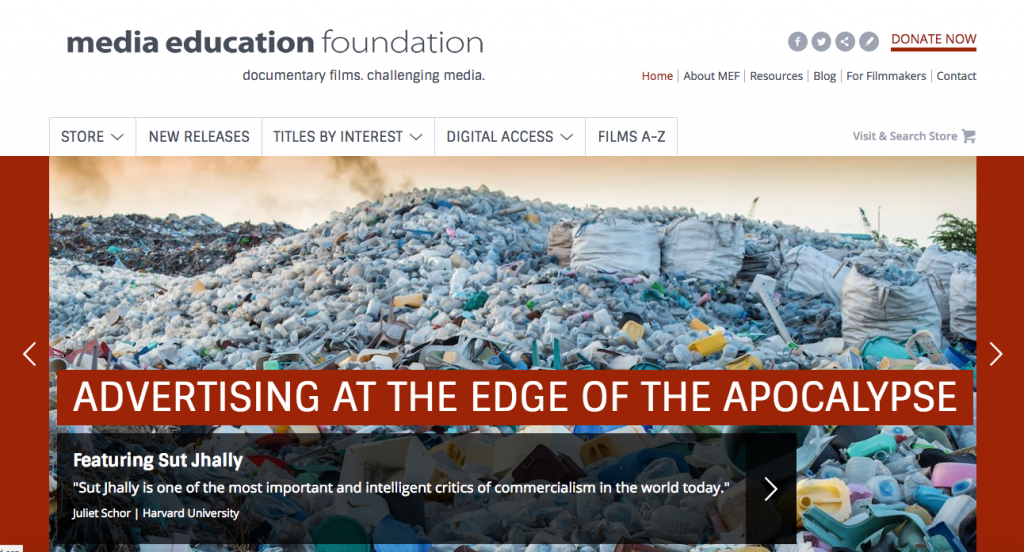 Since the above websites only provide the films, Subijanto uses the Media Education Foundation platform for their “Discussion Guides”. She often directs students to watch films on Thought Maybe or Kanopy and then provides them with the discussion guide questions from the Media Education Foundation.
Since the above websites only provide the films, Subijanto uses the Media Education Foundation platform for their “Discussion Guides”. She often directs students to watch films on Thought Maybe or Kanopy and then provides them with the discussion guide questions from the Media Education Foundation.
Course Artifacts
Below are a few example pairings of the Thought Maybe film + Media Education Foundation discussion guide questions for the COM 3060: Media Analysis and Criticism class.
Film: Requiem for the American Dream
After reading D. Croteau and W. Hoynes, “Media and the Social World” and Raymond Williams, “Communications and Community” (1961) as well as watching Requiem for the American Dream, please respond to the following questions by creating a new thread and adding a title (make it interesting and catchy!). Remember to come back and post a response to one of your colleagues’ replies and/or to the follow-up questions posted by the discussion leader. You are required to write a total of 3 posts, including your own initial response to the question below. The length of your post should be maximum 250 words. There is no minimum; however, you need to make sure you make a substantial, critical point in every post. See grading rubric for more information.
Discussion Question(s): Using the documentary film, make a reflection about how have political and economic changes transformed the United States. What kind of dangers does the current American economic and political system pose to the ordinary people in the US as well as globally? How have the people before us made path for progressive changes in this country? Connect this reflection on the perils and promises of democracy with your understanding of communication system that you have gained from reading Croteau and Hoynes’s as well as Williams’s articles. What are specific changes that need to be done to develop a “democratic” communication system?
Discussion leader: post your follow-up question(s) on a new thread and write “follow-up questions” in your subject line. If you want to add to an existing debate, you can also post follow-up questions within the existing thread(s) your friends have created. As a reminder: in addition to making 3 comments in the discussion, a discussion leader will need to pose at least one( 1) post consisting of follow-up question(s) after students respond on my first initial question(s). It is the responsibility of the discussion leaders to get the discussion going and interesting and to make sure that the discussion digs deeper into the materials in the readings/quizzes.
Film: YouTube, YouTubers, and You
After watching YouTube, YouTubers, and You, please respond to the following questions by creating a new thread and adding a title (make it interesting and catchy!). Remember to come back and post a response to one of your colleagues’ replies and/or to the follow-up questions posted by the discussion leader. You are required to write a total of 3 posts, including your own initial response to the question below. The length of your post should be maximum 250 words. There is no minimum; however, you need to make sure you make a substantial, critical point in every post. See grading rubric for more information.
Discussion Questions: After watching YouTube, YouTubers, and You, reflect on one of the the following themes and explain how Youtube changes and affects our cultures. What kind of negative and positive effects does Youtube create?:
- The monopoly Youtube own as the largest video search engine;
- Production of videos based on views, clicks, and ads;
- Production of cultural content and human creativity through the logic of digital labor.
- Use the story of one of the Youtubers on the documentary to illustrate your answers and connect your answers with the concepts from the readings we have discussed this week.
Discussion leader: post your follow-up question(s) on a new thread and write “follow-up questions” in your subject line. If you want to add to an existing debate, you can also post follow-up questions within the existing thread(s) your friends have created. As a reminder: in addition to making 3 comments in the discussion, a discussion leader will need to pose at least one( 1) post consisting of follow-up question(s) after students respond on my first initial question(s). It is the responsibility of the discussion leaders to get the discussion going and interesting and to make sure that the discussion digs deeper into the materials.
Film: Killing us Softly 4-Advertising’s Image of Women
After watching Killing us Softly 4-Advertising’s Image of Women, please respond to the following questions by creating a new thread and adding a title (make it interesting and catchy!). Remember to come back and post a response to one of your colleagues’ replies and/or to the follow-up questions posted by the discussion leader. You are required to write a total of 3 posts, including your own initial response to the question below. The length of your post should be maximum 250 words. There is no minimum; however, you need to make sure you make a substantial, critical point in every post. See grading rubric for more information.
Questions (taken from Media Ed Foundation): Choose one of the following questions and address it by referring to the readings by Tuchman and Banet-Weiser (make references from the readings to support your answers!). Make sure to include the number of the question you are answering in your title, e.g. #1, #2, or #3.
- How would you describe Jean Kilbourne’s point of view of women in advertising, overall? Can you think of other ways to look at the role of women in advertising that might contradict her central argument? What sort of reasoning might lead to a defense of how women are portrayed in advertising? What’s your own take?
- What is responsible advertising? Do advertisers have a responsibility to society? Do they have a responsibility to children? Why or why not?
- Write a story inspired by the following question: What does it mean to be a woman in our culture? The story doesn’t have to be based on personal experience (although it can be), but it should be realistic.
Discussion leader: post your follow-up question(s) on a new thread and write “follow-up questions” in your subject line. If you want to add to an existing debate, you can also post follow-up questions within the existing thread(s) your friends have created. As a reminder: in addition to making 3 comments in the discussion, a discussion leader will need to pose at least one( 1) post consisting of follow-up question(s) after students respond on my first initial question(s). It is the responsibility of the discussion leaders to get the discussion going and interesting and to make sure that the discussion digs deeper into the materials in the readings/quizzes.
Faculty Information
Rianne Subijanto is an Assistant Professor in the Department of Communication Studies at Baruch College, CUNY
Licensing Information
![]() The materials created for the Media Analysis and Criticism course are licensed under a Creative Commons Attribution-NonCommercial-ShareAlike 4.0 International License.
The materials created for the Media Analysis and Criticism course are licensed under a Creative Commons Attribution-NonCommercial-ShareAlike 4.0 International License.
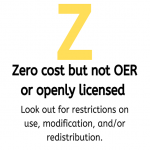 Resources from Kanopy and the Media Education Foundation are zero cost but not OER or openly licensed.
Resources from Kanopy and the Media Education Foundation are zero cost but not OER or openly licensed.
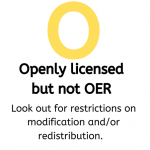 Materials from Thought Maybe are openly licensed but not OER.
Materials from Thought Maybe are openly licensed but not OER.
Image Credit: Film with Images by SalFalko
